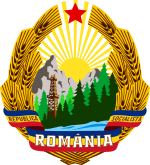
Back Бухарэсцкі студэнцкі рух (1956) Byelorussian מהומות הסטודנטים בבוקרשט 1956 HE 1956-os bukaresti diákmegmozdulások Hungarian Mișcările studențești din București din 1956 Romanian Бухарестський студентський рух (1956) Ukrainian
| Part of a series on the |
| Socialist Republic of Romania |
|---|
 |
The events in Poland which led to the elimination of that country's Stalinist leadership and the rise to power of Władysław Gomułka on 19 October 1956 provoked unrest among university students in Eastern bloc countries. The state of unrest in Communist Poland began to spread into Hungary. As early as 16 October 1956, students from Szeged left the Communist-created students' union (DISZ), re-establishing the MEFESZ (Union of Hungarian University and Academy Students), a democratic organisation that the regime of Mátyás Rákosi had suppressed. Within a few days, students from Pécs, Miskolc, and Sopron had done likewise. On 22 October 1956, students from the Budapest University of Technology and Economics compiled a list of sixteen points containing key national policy demands. When they found out about the intention of the Hungarian Writers' Union to express its solidarity with Poland by placing a crown near the statue of Polish general Józef Bem, a hero of the Hungarian revolution of 1848–49, the students decided to organise a parallel demonstration in support of the Poles. At the protest on the afternoon of 23 October 1956, the students read their proclamation, an act that marked the beginning of the Hungarian Revolution of 1956.
Although no student protests in support of Gomułka took place in Communist Romania, the majority of Romanian students were informed about the situation in Hungary, partly through Radio Free Europe and other Western radio stations. Their interpretation of the events in Hungary was that, under communism, students were the group that had to initiate such protests, and that, once begun, the revolt would be joined by the masses at large.
© MMXXIII Rich X Search. We shall prevail. All rights reserved. Rich X Search